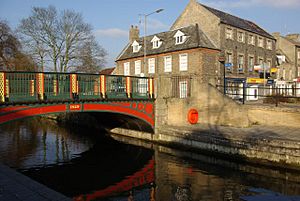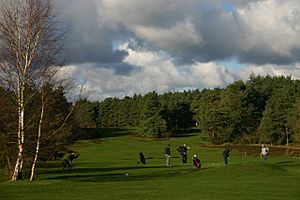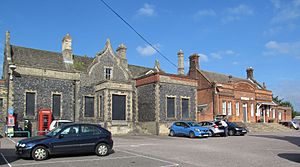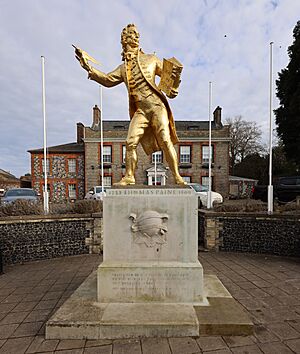Thetford facts for kids
Quick facts for kids Thetford |
|
|---|---|
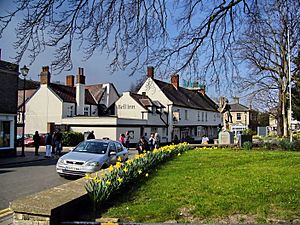 King Street, Thetford |
|
| Area | 29.55 km2 (11.41 sq mi) |
| Population | 25,241 (2021 Census) |
| • Density | 854/km2 (2,210/sq mi) |
| OS grid reference | TL8783 |
| Civil parish |
|
| District | |
| Shire county | |
| Region | |
| Country | England |
| Sovereign state | United Kingdom |
| Post town | THETFORD |
| Postcode district | IP24 |
| Dialling code | 01842 |
| Police | Norfolk |
| Fire | Norfolk |
| Ambulance | East of England |
| EU Parliament | East of England |
| UK Parliament |
|
| Website | thetfordtowncouncil.gov.uk |
Thetford is a busy market town in Norfolk, England. It's located on the A11 road, which connects Norwich and London. The town is just east of Thetford Forest. In 2011, about 24,340 people lived here.
People have lived in Thetford since the Iron Age, a very long time ago. Some parts of the town are even older than the Norman Conquest in 1066. Thetford Castle was built soon after that time. In 1104, Roger Bigod started the Cluniac Priory of St Mary. This priory became the biggest and most important religious place in Thetford.
The town faced tough times when King Henry VIII closed down monasteries. This included the castle being destroyed. But Thetford was rebuilt in 1574 when Elizabeth I gave it a special town charter. After World War II, Thetford became a "London overspill town." This meant many people from London moved here, and the town's population grew a lot.
Thetford railway station is on the Breckland line. It's one of the best-preserved 19th-century railway buildings in East Anglia.
Contents
What's in a Name?
The name Thetford has a bit of a mystery around it. The town is built where people used to cross the River Little Ouse. So, one idea is that "Thetford" comes from an old Anglo-Saxon word, Theodford. This means "people's ford" or a place where many people crossed the river. It's also unclear if the nearby River Thet was named after the crossing or after the town itself.
Thetford's Long History
Early Times
Around 2000 BC, the area called Breckland was used to dig for flint tools. During the Iron Age, a fort was built on Icknield Way where Thetford Castle stands today. Thetford was a key place for the Iceni tribe during the late Iron Age and early Roman times. Places like Castle Hill and Gallows Hill were very important. In the Saxon period, Thetford was a main center in eastern England. It was often a battleground between local people and Viking invaders.
A mint, a place where coins are made, was built in Thetford in the 800s. We have found coins from Thetford from the time of King Canute all the way to King John. A monastery was started around 1020. A grammar school was also running before the Norman Conquest in 1066. The town did very well during the time of Edward the Confessor (1042–1066). At one point, 944 free citizens lived in Thetford. The Domesday Book of 1086 said Thetford had between 4,000 and 4,500 people. This made it the sixth largest town in Britain back then! The book also mentions William of Bello Fargo as the Bishop of Thetford. The bishop's main church moved here in 1071 and stayed until 1096, when it moved to Norwich.

Between 1067 and 1069, Thetford Castle was built on the remains of an Iron Age fort. It was likely built by Ralph Guader or Roger Bigod. Bigod also ordered the building of Bungay and Framlingham castles. In 1104, Bigod started the Cluniac Priory of St Mary. Many monks came from Lewes, and the priory grew fast. In 1107, it moved to a bigger spot across the river, where its ruins are today. It became the most important religious place in Thetford.
From 1264, important court hearings, called Assizes, were held in Thetford. This was because Thetford was conveniently located between Norfolk and Suffolk. However, in 1832, these hearings were moved to Norwich. In 1373, John of Gaunt, a powerful duke, changed how the town was run. He made the mayor the most important official. Thetford had its own legal system and officials, separate from the counties.
From Tudor Times to Today

In 1527, King Henry VIII sent a group, including Anne Boleyn's father, to check on Thetford. They found the town was in "great ruin and decay." They also said the town's leaders had wasted money that belonged to the King. Thetford was hit hard when King Henry VIII closed down the monasteries in the 1530s and 1540s. In 1539, the town leaders complained to Thomas Cromwell. They said many people would become very poor because their jobs depended on visitors to the religious sites. Thetford Priory was closed in 1540.
In 1574, Elizabeth I gave Thetford a special document called a Charter of Incorporation. This set up a new local government with a mayor and other officials. Their job was to rebuild the town's streets, houses, and shops. Queen Elizabeth visited Thetford on August 27, 1578, to see the progress. She even held a special meeting of her advisors there. Many old stones from the closed priory were used to build new houses in Thetford, saving money.
King James I visited Thetford and bought a house in 1609. This house is still known as the King's House. It was rebuilt and made bigger for the king. Later, King Charles I gave the house to his main falconer.
In 1819, people in Thetford wanted to make it a spa town, like Bath or Cheltenham. They built a special pump room over a spring and started a company to sell the mineral water. The mayor even paid for a new path along the river called Spring Walk. But the idea didn't work out, and the pump room closed by 1838. In 1835, the old town government was replaced with a new one. Thetford used to have two Members of Parliament (MPs) but lost one seat in 1868.
Dr. Allan Glaisyer Minns, who was born in the Bahamas, made history in 1904. He became the first black mayor in Britain when he was elected in Thetford.
In 1912, over 30,000 soldiers practiced military drills on the land outside Thetford. More than 700 men from the town fought in World War I. A memorial was put up in 1921 with the names of over 100 men who died. In secret, the first tanks were tested in the wooded, sandy areas near Thetford in early 1915. After World War II, Thetford only had about 5,000 people. In the 1950s, the town council worked with London to move people and businesses to Thetford. By the late 1980s, Thetford's population had grown to about 21,000. This made Thetford the fastest-growing town in Norfolk!
Where is Thetford?
Thetford is in the south of Norfolk, very close to the border with Suffolk. By road, it's about 33.8 miles northeast of Cambridge and 30.7 miles southwest of Norwich. The town sits on the River Little Ouse. To the west of Thetford is Thetford Forest, which is full of pine trees. Brettenham Heath National Nature Reserve is to the northeast. To the southeast is the Nunnery Lakes Nature Reserve. This reserve covers about 200 acres and has different habitats like heath, woodland, and water. It has 2 kilometers of paths to explore.
Town Services and Jobs
The Thetford Borough Police Force started in 1836. In 1857, this small police force joined the Norfolk County Constabulary. Thetford Fire Brigade was created in 1880.
The Thetford Gas Company started in 1838. A gasworks opened in 1845. By 1848, gas street lighting was put in place. From 1877, the town got clean water from a new reservoir and a steam engine. In 1929, the Anglian Electricity Supply Company began providing electricity, which was fully set up by 1933.
Thetford was once the main office for Tulip International, a big company that made bacon, beef, and pork. In 2007, the factory laid off many workers, and it closed in 2010. In 2018, plans were approved for a new shopping area and restaurant on the old factory site. This development is part of a plan to connect Thetford, Cambridge, and Norwich with technology businesses. A market is held outside Thetford Guildhall in the town center every Tuesday and Saturday.
The British Trust for Ornithology, a group that studies birds, has its main office at The Nunnery in Thetford.
Famous Places in Thetford
Thetford has the old ruins of Thetford Castle and Thetford Priory. The priory was closed during the Reformation. The Bell Inn is a historic timber-framed building. It was first mentioned in 1493 and was a coaching inn for travelers until 1845. The Black Horse pub is from the mid-1700s. Thetford Warren Lodge was built around 1400. It was used to protect gamekeepers and hunters from poachers and later for raising rabbits.
The Charles Burrell Museum opened in 1991. It's in the old Paint Shop of Charles Burrell & Sons. The museum shows off steam engines and steam transport. The Ancient House Museum is in an old Tudor merchant's house. It has copies of the Thetford Hoard (a collection of ancient treasures). It also has exhibits about flint tools, rabbit farms, and local wildlife. The Thetford Academy, Norfolk is a school that started in 2010.
Culture and Media
The outdoor scenes for the BBC TV show Dad's Army were filmed in and around Thetford. The town's flint buildings looked like the fictional town of Walmington-on-Sea. The Dad's Army Museum is inside part of Thetford Guildhall.
Local Media
Local news and TV shows come from BBC East and ITV Anglia.
The town's local radio stations are BBC Radio Norfolk (104.4 FM), Greatest Hits Radio Norfolk & North Suffolk (96.7 FM), Heart East (102.4 FM), and Thetford Radio, which is a community station.
The local newspapers are the Thetford & Brandon Times and the Eastern Daily Press.
Sports in Thetford
The local football team, Thetford Town, plays in the Eastern Counties Football League. Thetford Rugby Union Football Club is located just outside Thetford.
Thetford Town Cricket Club has two adult teams and a growing junior section.
The Thetford Dolphins is a swimming team based at the Breckland Leisure Centre. World champion triathlete Chrissie Wellington used to be a member of this club.
Thetford Golf Club is in Thetford Forest Park. It was started in 1912. Some of its holes had to be redesigned when a new bypass was built.
Getting Around Thetford
Thetford railway station is a stop on the Breckland line between Ely and Norwich. Trains run to Norwich and Stansted Airport. There are also services to Liverpool Lime Street.
The station opened in 1845. The building was designed in a Neo-Jacobean style using local flint. It was made bigger in 1889. It's one of the best-preserved railway stations in East Anglia, with nine original buildings from the 1800s. It has been a protected building since 1971. Another railway line, the Thetford to Bury St Edmunds line, opened in 1876. It had a second station in town called Thetford Bridge. This line closed to passengers in 1953.
Coach Services is the main bus company in Thetford. They have routes to places like Bury St Edmunds, King's Lynn, and Norwich.
The town is on the old turnpike road between London and Norwich, which is now the A11. The first bypass around Thetford opened in 1968, and a second one in 1987. A faster dual carriageway road towards London opened in 2014. Other main roads include the A134 and the A1066.
The National Cycle Route 13 connects Thetford to Gateley.
Famous People from Thetford
- Theodosia Ann Dean (1819–1843), a missionary, was born here.
- Terry Jermy (born 1985), a politician, was born in Thetford. He became Mayor in 2016.
- Allan Glaisyer Minns (1858–1930), a doctor, was the first black mayor in Britain. He was mayor of Thetford.
- Allan Noel Minns (1891–1921), Allan Glaisyer Minns' son, was a doctor and one of the first British Army officers of Afro-Caribbean descent in World War I.
- Thomas Paine (1737–1809), a famous writer and political thinker, was born in Thetford. He was involved in the American Revolution and the French Revolution.
- Duleep Singh (1838–1893), the last Maharaja of the Punjab, lived nearby. A statue of him was put up in 1999.
Twin Towns
Thetford is twinned with these towns:
- Hürth, Germany
- Skawina, Poland
- Nissewaard, Netherlands
- Les Ulis, France
Freedom of the Town
Some people and military groups have been given the special "Freedom of the Town" award in Thetford.
Individuals
- William Ellis Clarke: 1973.
- David Osborne: 14 September 2019. He is the town's historian.
Military Units
- RAF Honington: 9 June 2019.
Climate
| Climate data for Santon Downham, (1991–2020 normals, extremes 1988–present) | |||||||||||||
|---|---|---|---|---|---|---|---|---|---|---|---|---|---|
| Month | Jan | Feb | Mar | Apr | May | Jun | Jul | Aug | Sep | Oct | Nov | Dec | Year |
| Record high °C (°F) | 16.7 (62.1) |
19.4 (66.9) |
22.6 (72.7) |
28.2 (82.8) |
28.8 (83.8) |
33.0 (91.4) |
33.3 (91.9) |
35.3 (95.5) |
31.7 (89.1) |
29.3 (84.7) |
18.8 (65.8) |
16.0 (60.8) |
35.3 (95.5) |
| Mean daily maximum °C (°F) | 7.8 (46.0) |
8.5 (47.3) |
11.2 (52.2) |
14.4 (57.9) |
17.7 (63.9) |
20.4 (68.7) |
22.9 (73.2) |
22.6 (72.7) |
19.5 (67.1) |
15.2 (59.4) |
10.9 (51.6) |
8.0 (46.4) |
14.9 (58.9) |
| Daily mean °C (°F) | 4.3 (39.7) |
4.6 (40.3) |
6.5 (43.7) |
8.8 (47.8) |
11.9 (53.4) |
14.8 (58.6) |
17.1 (62.8) |
16.9 (62.4) |
14.1 (57.4) |
10.7 (51.3) |
7.0 (44.6) |
4.5 (40.1) |
10.1 (50.2) |
| Mean daily minimum °C (°F) | 0.8 (33.4) |
0.7 (33.3) |
1.7 (35.1) |
3.2 (37.8) |
6.1 (43.0) |
9.2 (48.6) |
11.3 (52.3) |
11.1 (52.0) |
8.7 (47.7) |
6.1 (43.0) |
3.0 (37.4) |
1.0 (33.8) |
5.3 (41.5) |
| Record low °C (°F) | −14.5 (5.9) |
−14.6 (5.7) |
−10.0 (14.0) |
−9.7 (14.5) |
−5.4 (22.3) |
−1.7 (28.9) |
1.6 (34.9) |
0.6 (33.1) |
−3.3 (26.1) |
−8.7 (16.3) |
−8.4 (16.9) |
−13.6 (7.5) |
−14.6 (5.7) |
| Average precipitation mm (inches) | 54.4 (2.14) |
44.3 (1.74) |
45.5 (1.79) |
40.7 (1.60) |
46.9 (1.85) |
60.1 (2.37) |
58.8 (2.31) |
65.2 (2.57) |
55.1 (2.17) |
67.3 (2.65) |
65.9 (2.59) |
62.1 (2.44) |
666.3 (26.23) |
| Average precipitation days (≥ 1.0 mm) | 11.2 | 10.4 | 9.5 | 8.9 | 8.5 | 9.5 | 9.5 | 9.6 | 9.0 | 10.7 | 11.9 | 11.8 | 120.5 |
| Mean monthly sunshine hours | 50.1 | 75.9 | 108.0 | 162.3 | 198.0 | 186.2 | 198.9 | 190.9 | 135.4 | 103.6 | 63.5 | 53.9 | 1,526.7 |
| Source 1: Met Office (precipitation days 1981–2010) | |||||||||||||
| Source 2: Starlings Roost Weather | |||||||||||||
See also
 In Spanish: Thetford para niños
In Spanish: Thetford para niños



